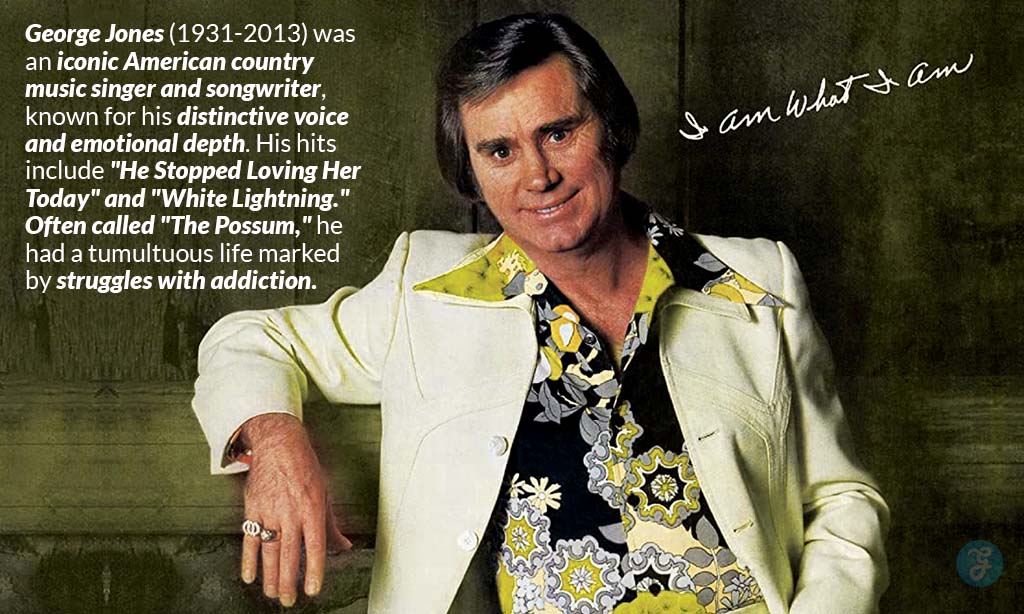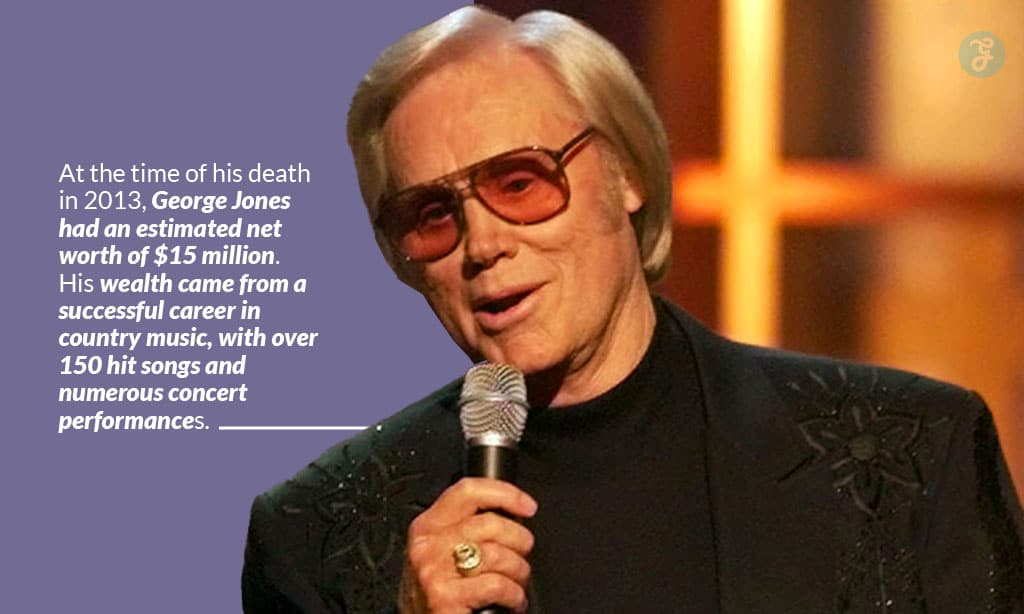Many people wonder about famous singers’ money. They ask, “How much did they make?” For fans of country music, this question often comes up about George Jones. Known for hits like “He Stopped Loving Her Today,” his story is not just about songs.
It’s also about money.
George Jones net worth was $15 million when he passed away in 2013. This fact surprises some fans. Even with ups and downs in his career, he made a lot of money from hits and concerts.
Our article will show you how George Jones made and spent his wealth. Let’s look at the rich legacy behind George Jones net worth!
Early Life and Beginnings
George Glenn Jones was born on September 12, 1931, in Saratoga, Texas. He grew up in Colmesneil with one brother and five sisters. His life in music started early. At age 9, his father gave him his first guitar.
This gift sparked something big inside George. It planted the seed for a career that would become legendary.
At just 16 years old, George made a bold move. He left home to chase his dream of music fame. This step marked the start of an incredible journey in country music. It wasn’t easy, but it set the stage for George Jones to become a household name across America and beyond.
The Rise of George Jones’ Music Career
George Jones started recording songs, making his way into the music world. His talent soon caught fire, leading to a career filled with hits and accolades.
First Recordings and Breakthrough
He made his first song, “No Money in This Deal” in February 1954. It was the start of something big for him. Then came a turning point with “Why Baby Why” in 1955. His songs started to catch people’s ears.
Success grew and by 1959, he had his first number one song, “White Lightnin’.” People loved it and couldn’t get enough. This hit showed everyone that he was a star in country music.
His early work set the stage for many hits to come. Songs like these made him famous and brought fans from all over. They also helped shape country music into what it is today.
Commercial Success and Chart-Topping Hits
George Jones became a big name in country music with songs that many people loved. His song “She Thinks I Still Care” came out in 1962, and it was a hit. Later, hits like “The Grand Tour” in 1974 and “He Stopped Loving Her Today” in 1980 made him even more famous.
These songs helped George earn the title “The Rolls-Royce of Country Music.” He had over 160 chart singles between 1955 and 2013, showing how much people liked his music.
His success wasn’t just because of his voice. George worked with other stars too, making songs that fans couldn’t forget. Songs like “Golden Ring” with Tammy Wynette showed this teamwork.
Every time he sang at concerts or on TV shows like The Grand Ole Opry, more fans wanted to listen to his music. This love for his tunes meant George kept having hits year after year, keeping him at the top of country music for a long time.
George Jones Net Worth at Its Peak
George Jones made a lot of money from his songs and shows. His bank balance was very high when he was most famous. George Jones net worth was $15 million at 2013 when he died.
Earnings from Music Sales
Music sales played a big part in building the wealth of country music icon George Jones. He made a lot of money from hits like “White Lightning” and “He Stopped Loving Her Today.” These songs were not just popular; they sold millions of copies and stayed at the top of country music charts for weeks.
This success meant George earned lots from record sales.
He won a Grammy Award for Best Male Country Vocal Performance in 1980, which boosted his album sales even more. Each album he released added to his earnings. Concerts and tours also brought in cash, but it was his music sales that laid the foundation for his financial success.
Over the years, these sales turned into big amounts, making George Jones very wealthy by any standard. However, George Jones net worth was $15 million at the time of his death in 2013.
Revenue from Concerts and Tours
George Jones hit the road hard, playing at least 60 concerts each year until his last moments. The tours, including the big “The Grand Tour” farewell in 2012, brought in a lot of money.
People from all over came to see him live. They paid for tickets, bought T-shirts, and collected memorabilia that added up to a large sum.
These tours weren’t just about singing old hits; they were events where fans felt connected to George Jones’s music on a personal level. Every concert was an opportunity for Jones to earn more, keep his legacy alive, and show why he remained a giant in country music.
From small towns to big cities across the country, these performances were key in making sure George Jones stayed not only relevant but also financially strong during his years on stage.
Royalties and Licensing Deals
Royalties and licensing deals were big for George Jones. Every time someone played his songs on the radio or used them in movies, he made money. This included hits like “He Stopped Loving Her Today.” These deals also covered when other artists wanted to sing his songs.
They had to pay him. His music reached many people this way.
His agreements with companies like United Artists helped too. They made sure he got paid well for his work. Over time, these payments added up to a lot of money for George Jones. This was a smart move in the music world.
It kept earning him money, even when he wasn’t making new songs.
Financial Struggles and Setbacks
George Jones faced tough times with money due to his battle with alcohol and legal troubles, making his journey one filled with ups and downs. To learn more about how he overcame these challenges, keep reading.
Impact of Alcoholism on Finances
Alcoholism hit George Jones hard. It led him to spend a lot of money on drinks and miss work. He had to go to the hospital in 1967 because of his drinking. Even after getting help at Hillcrest Psychiatric Hospital in 1980, he went back to drinking.
This hurt his ability to make money from music tours and record sales.
His spending on alcohol also caused legal problems and debt. Missing shows meant losing income and facing lawsuits from promoters. These issues took away from the money he earned through his career, making it tough for him financially despite being a top country singer.
Legal Issues and Debt
George Jones faced tough times with money. In 1978, he filed for bankruptcy because he had a lot of debt. He owed $36,000 in child support and said he was $1 million in debt. This was a huge problem for him.
Financial troubles hit him hard.
By February 1979, things got worse for George Jones. He lived in his car and weighed under 100 pounds. His battles with alcoholism also hurt his finances a lot. Money problems were big during this part of his life, showing how serious debt and legal issues can get.
The Comeback Era of George Jones
George Jones turned his career and finances around during the Comeback Era, signing new deals and making hit songs again. Keep reading to see how he did it.
Revival of Career and Financial Stability
Jones made a big comeback with “He Stopped Loving Her Today” in 1980. This song brought him back to the top of country music. With this hit, he started to make more money from his music again.
He went on tours and did concerts that sold many tickets.
In 2012, Jones got a Grammy Lifetime Achievement Award. This award showed how important he was in music. It helped make sure people remembered his work. Because of this award and other successes, his finances got better over time.
Collaborations and Duets
George Jones teamed up with big names like Tammy Wynette, Merle Haggard, and Johnny Cash. These team-ups brought us songs that many people love. Songs like “We’re Gonna Hold On,” “Golden Ring,” and “Two Story House” are still played today.
Working together made these tracks special.
These songs were not just hits; they told stories that touched many hearts. With Wynette, his voice blended in a way that made each song memorable. With Haggard and Cash, the power of country music grew stronger.
Each duet was more than a song—it was a moment in music history everyone remembers.
Legacy and Later Years of George Jones
George Jones left a mark on country music that keeps influencing singers today, showing how legends never really fade away. Discover more about his lasting impact and the wealth he built over decades.
Continued Success and Influence in Country Music
He kept making music that fans loved. His songs stayed popular and he still played big shows. People in country music looked up to him a lot. He got into the Country Music Hall of Fame in 1992.
This was a big deal. Then, in 2008, he got another big honor from the Kennedy Center.
Many singers wanted to sing with him or say they were like him. Big names like Alan Jackson and Garth Brooks said his work meant a lot. He changed how country music sounded and showed others how to make great songs too.
Everyone who likes country music knows his name and his voice even now.
Investments and Estate Planning
George Jones made smart moves with his money and land. He bought a big property in Franklin, Tennessee, in the 1990s. This place had 80 acres. Before he passed away in 2013, he sold part of this land, 54 acres, for $2.4 million.
These actions showed Jones knew how to plan for the future.
He also thought about what would happen after he was gone. By managing his estate well, Jones made sure his wealth would keep supporting his family and projects he cared about. His decisions in investments and planning were as sharp as his music career.
The Country Gold Estate
The Country Gold Estate shines bright in George Jones’ story, a place filled with history and beauty. Check it out for an unforgettable journey into the heart of country music’s rich legacy.
Overview of the Estate’s Features
George Jones built Country Gold Estate in 1993. This large home is 9,700 square feet. He wanted to sell it for $15 million in 2011. The house has many rooms and big spaces for family and guests.
It was made with care and style, thinking of comfort and luxury.
The estate stands out in the world of country music homes. It reflects George Jones’s success and taste. People see it as an important part of his legacy. The big house and its land show how successful he became through singing songs that touched many hearts.
Value and Historical Significance
The Country Gold Estate has a big story. It was first put up for auction, but the offer of $2 million was too low. Later, George Jones’s widow sold it for $1.98 million in 2015. This estate is not just land and a house.
It tells the tale of country music history and George Jones’s life.
This place saw many gatherings, songs, and moments that shaped music. Selling for such a price shows how valuable George Jones’s legacy is to country music fans and history lovers alike.
George Jones Net Worth at the Time of Death
George Jones net worth was a topic of much interest. Explore more to learn about the legacy he left behind in terms of wealth and impact on music.
Breakdown of Assets
George Jones was a legend in country music. George Jones net worth was $15 million at his death.
- Music sales brought in lots of money. George’s songs were hits for many years.
- Concerts and tours added to his wealth. He traveled all over, singing to fans.
- Royalties from songwriting were big earnings for him. Every time someone played his music, he got paid.
- Licensing deals helped too. Brands used his music in ads and movies.
- His house was worth a lot. It was big and had historical value.
- George owned land too, which increased his wealth.
- Investments he made over the years grew in value.
- Personal items, like guitars and stage outfits, were valuable, especially to fans.
- After he died, his music kept selling. This meant more money came in even though he was gone.
George Jones left behind not just great music but also a big financial legacy.
Estimated Total Worth
At the time of his death, George Jones had built a significant fortune. His wealth came from songs, concerts, and deals he made over many years. Estate sales and royalties added more to his bank account after he passed away.
Jones was not only a singer but also ranked No. 24 on Rolling Stone’s “200 Greatest Singers of All Time” in 2023. This honor shows how much people still love his music. His legacy lives on through his timeless hits and the money they keep earning.
Posthumous Earnings and Legacy
After George Jones passed away, his music saw a spike in sales, proving that legends never truly die. His timeless hits continue to inspire artists and fans across genres, from country to rock.
Dive into the full story to explore how his legacy shapes today’s music scene.
Sales of Music After Death
George Jones was a country music legend. Even after he passed away, his songs kept making money. His estate gets royalties from over 150 hit tunes. Fans still buy his music and listen to it online.
Jones’ hits keep touching new fans. Every time someone plays his songs on the radio or streams them, his estate earns a bit more. This shows how loved his music is across different ages.
Impact on Future Generations of Artists
Alan Jackson and Merle Haggard look up to him. So do many other country singers. They all learned something from his music. His songs tell stories about life, love, and loss that touch people deeply.
This makes new artists want to write songs like his. They see how real feelings can make great music.
His style also changed country music. Now artists mix traditional sounds with new ideas, just like he did. This blend keeps the genre fresh and exciting for listeners everywhere. His influence shows in the work of many musicians today, making sure his legacy lasts for a long time.
Takeaways
George Jones had a life full of highs and lows, much like his songs. His music touched many, making him a legend in country music. From a rough start to reaching the stars, Jones showed what hard work can do.
At his death, he left behind $15 million, proof of his success and talent. Even after he was gone, his tunes still play on, inspiring new singers every day.












































